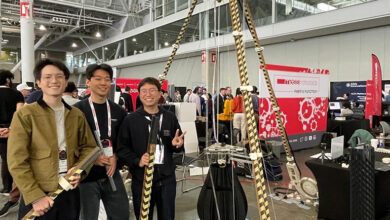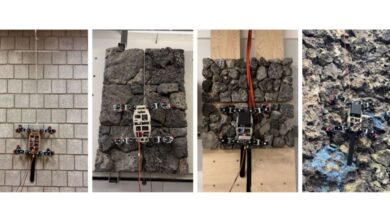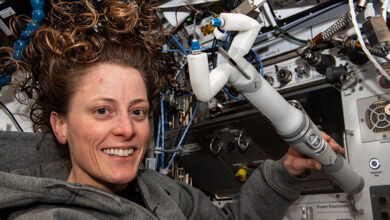Robotics WorX Program aims to bring real-world solutions to manufacturing
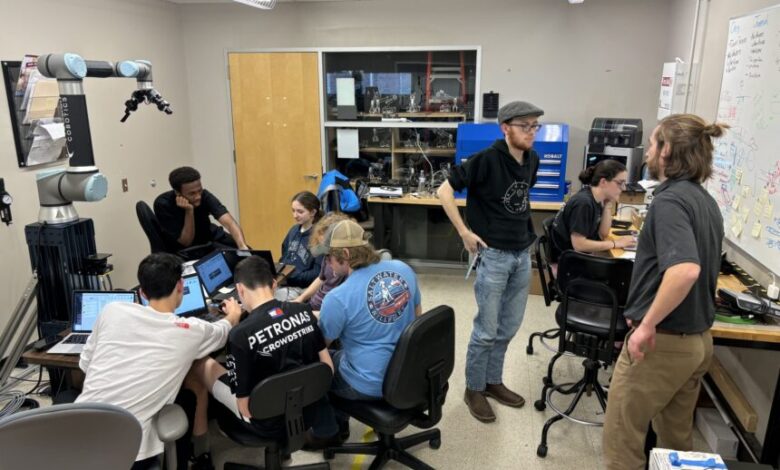
Robotics are helping manufacturers keep up with demand in a climate of workforce shortages.
The robots, which often do redundant tasks, allow manufacturers to use workers for more constructive jobs.
A local company, born out of the need for automation at its sister company, has partnered with Millersville University (MU) to not only solve specific problems manufacturers have, but increase the manufacturing workforce.
John Bridgen, president of Precision Cobotics in Lititz, said the Robotics WorX program enlists MU students in the Automation and Robotics program to take real manufacturing problems and use robots to find solutions in the Precision Cobotics Solutions Lab at Millersville.
“We don’t make stuff, we create the things that make stuff,” Bridgen said.
The program, partially funded by grants from Lancaster STEM and the Lancaster County Workforce Development Board, also works with high school students with the hope of inspiring them to take an interest in manufacturing.
“The demand for domestic manufacturing is increasing after COVID-19 showed us the need to produce things here,” he said. “But the workforce is decreasing so we need to find a way to spark interest in young people.”
Bridgen, who said he has been drawn to automation and manufacturing since he participated in a program for kids at M&M Mars in Elizabethtown where he grew up, said inspiring young people to explore manufacturing is an important part of the program.
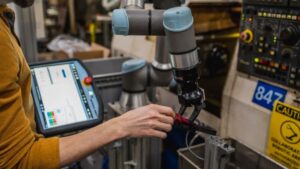
He joined Precision Cobotics after it was formed from sister company Precision Form Inc., formerly a division of Alcoa Inc. which manufacturers parts for the automotive, electrical, electronics, aerospace and building industries.
Precision Cobotics was formed from within Precision Form as a small team in 2018 to solve manufacturing issues, Bridgen explained. He joined the company when it became a stand alone in 2022.
“Precision Cobotics started working with an intern from MU in 2019,” Bridgen said. “Based on the success the team had creating robots that could do repetitive tasks, the idea for the Robotic WorX program was born.”
John Haughery, assistant professor of Automation and Electronic Technologies and program coordinator for Automation and Robotics Engineering Technology at MU, said six students work as interns for Precision Cobotics in the Solutions Lab the company created at MU.
“They (the students) provide proof of concept solutions,” he said. “They can get a robot to take a part off a machine and put it where it needs to go.”
Haughery said companies don’t want to spend money on robotics until they can see what they can do and how they can improve the manufacturing process.
“We show what is possible and estimate what it would cost,” he said.
“Manufacturing is losing people to retirement and there are not enough to replace them,” Haughery said. “Americans love to consume but we need to manufacture things. The need to reshore in increasing but the availability of workers in decreasing. Automation can solve both of those.”
Because of the need for workers, the program works with high school students as well as the college interns. Bridgen said about 400 high school students from Pequea Valley, Ephrata, Garden Spot, Conestoga Valley, Manheim Township and Columbia school districts have participated so far with half taking a three-hour tour of the facility and half job shadowing, which allows them to work on real-world problems.
Haughery said six high school students are working in the lab even more to learn the ropes and he hopes to attract more school districts to the program.
During the summer months, the MU interns work at Precision Cobotics, Bridgen said. The high school students can’t because they must be 18 to work in manufacturing.
Bridgen said the company starts with Universal Robots which are robots that are not guarded and can work alongside a person. The team at MU takes a manufacturing problem and transforms the robots to do the task needed.
Haughery used an example of a machine that makes industrial pins that need to be taken off the manufacturing machine and placed into a shipping container.
“Students can create a robot that can pull a raw piece of material and put it in a machine which stamps it and then pull it out and put it in a box. It’s repetitive work,” he said. “They pick things up and put them down.”
The robots have sensors on each joint so they can sense how much pressure they’re using, he said.
“They are meant to work with people safely so they can do the easy job and allow the workers to do more complex things,” Haughery added.
“We train people to take ownership of the robot,” Bridgen said. “We use AI for quality inspection and guidance.”
Bridgen said the lab came out of the increased demand from the government after COVID-19 when geopolitical pressures increased to make products domestically.
“To develop the workforce, we partnered with MU to develop talent to scale manufacturing,” he said. “Young people like to play with robots.”
The real world experience gained through the program will inspire the students to work in manufacturing, which will grow manufacturing, Bridgen said.
The cobot market made $17 billion in 2023. Bridgen said it is expected to reach $12.7 billion by 2030.
“This is an important trend in manufacturing,” he said, adding Precision Form’s contract with the Department of Defense will net it double digit growth. “This is important to national security.”
Precision Cobotics has grown year over year and now employs 10. The company plans to hire as many of the interns as possible to continue its growth trajectory.
“They are allowing us to grow the business now so they are a help even before we hire them,” he said.
